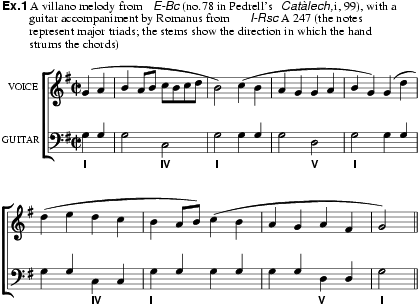
(Sp.: ‘villain’, ‘peasant’; It. villan di Spagna).
A sung dance popular in Spain and Italy during the 16th and 17th centuries. Diego Sánchez de Badajoz mentioned it with the canary in the Farsa de Sancta Bárbara (in his Recopilación en metro, Seville, 1554), and Francisco de Salinas gave its melody in De musica libri septem (1577/R, p.296). There are numerous literary references from the 17th century, in works of Cervantes, Lope de Vega, Calderón and others. Its choreography was described by Esquivel in Discursos sobre el arte del dançado (1642/R); Briçeño, in his Método mui facilissimo (1626), provided guitar music and text for two examples, each with a two-line refrain and two four-line strophes. A manuscript in the Biblioteca Riccardiana (I-Fr 2973 [III]) gives guitar chords for what appears to be a four-line refrain, but most refrain texts are similar to Briçeño’s first example:
Al villano que le dan
La çebolla con el pan
The music of the villano is built on the recurring harmonic pattern I–IV–I–V–I (a progression used also in the canary, sarabande and passamezzo moderno) with various discant melodies added. The lower staff of ex.1 shows a typical guitar accompaniment, which spans four lines of text (the melody on the top staff actually continues for four more phrases in the manuscript). For comparison, ex.2 presents an Italian keyboard version, with sufficient music to fit six lines of poetry (corresponding chords have half the note value of those in ex.1). Chordal villanos for the five-course Spanish guitar appear in at least 25 Italian tablatures between 1606 (Montesardo) and 1677 (Ricci). Giamberti included a Villan de Spagna among his instrumental duos of 1657 (repr. 1664, 1677 and 1689). The Bentivoglio manuscript (US-SFsc) contains an example for lute, and the third edition of Matteo Coferati’s Corona di sacre canzoni (1710) gives a discant melody (repr. in AcM, xliv, 1972, p.213). Spanish sources include guitar villanos by Sanz (1674), Ruiz de Ribayaz (1677) and Guerau (1694), a set of keyboard variations in Martín y Coll’s collection (E-Mn 1360) and a choral setting with text (E-Mn 1370). The villano may still be found in the folk music of Spain (see Spain, §II, 4).


F. Pedrell: ‘Folk-lore musical castillan du XVIe siècle’, SIMG, i (1899–1900), 372–400
E. Cotarelo y Mori: Colección de entremeses (Madrid, 1911), pp.cclxiii–cclxv
M. Querol Gavaldá: La música en las obras de Cervantes (Barcelona, 1948), 125–7
M. Querol Gavaldá: ‘El villano de la época de Cervantes y Lope de Vega y su supervivencia en el folklore contemporáneo’, AnM, xi (1956), 25–6
M. García Matos: ‘Viejas canciones y melodías en la música instrumental popular de las danzas procesionales practicadas aún en España’, Miscelánea en homenaje a Monseñor Higinio Anglés (Barcelona, 1958–61), i, 290–1
J.C. Escudero: ‘La méthode pour la guitare de Luis Briçeño’, RdM, li (1965), 142–3
R. Hudson: ‘The Music in Italian Tablatures for the Five-Course Spanish Guitar’, JLSA, iv (1971), 21–42
RICHARD HUDSON